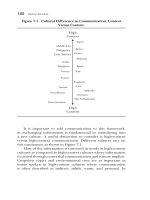Chapter 6: Strategy in the Global Environment
Bạn đang xem bản rút gọn của tài liệu. Xem và tải ngay bản đầy đủ của tài liệu tại đây (298.54 KB, 25 trang )
Chapter 6
Strategy in the Global
Environment
The Global Environment
•
Managers need to consider:
–
How globalization is impacting the
environment in which their company competes
–
What strategies they should adopt to exploit
opportunities
–
How to counter competitive threats
The Global Environment
•
Industry boundaries do not stop at national
borders
•
The shift to global markets has intensified
competitive rivalry in industries
•
Global markets created enormous
opportunities
Increasing Profitability Through
Globalization
•
The success of many multinational companies is
based not just on the goods and services they
sell, but upon the distinctive competencies that
underlie their production and marketing
•
Globalization increases profits by:
–
Expanding the market
–
Realizing economies of scale
–
Realizing location economies
–
Leveraging the skills of global subsidiaries
Competitive Pressures
•
Two main pressures:
–
Pressure for cost reduction
–
Pressure to be locally responsive
•
These pressures place conflicting
demands on a company
Cost Reductions
•
Cost reductions are common in:
–
Industries where price is the main competitive weapon
–
Industries with universal need products
–
Universal Need: When consumer preference is similar
or identical in different nations
•
Companies may achieve cost reduction by
basing production in a low-cost location or by
offering a standardized product.
Figure 6.1: Pressures for Cost
Reduction and Local
Responsiveness
Local Responsiveness
Pressures
•
These arise from differences in:
–
Consumer taste and preferences
–
Infrastructure or traditional practices
–
Distribution channels
–
Host government demands
•
The more that customer preferences vary,
the more local responsiveness is required
Choosing a Strategy
Basic four strategies:
1. Global Standardization Strategy
2. Localization Strategy
3. Transnational Strategy
4. International Strategy
Figure 6.2: Four Basic
Strategies









